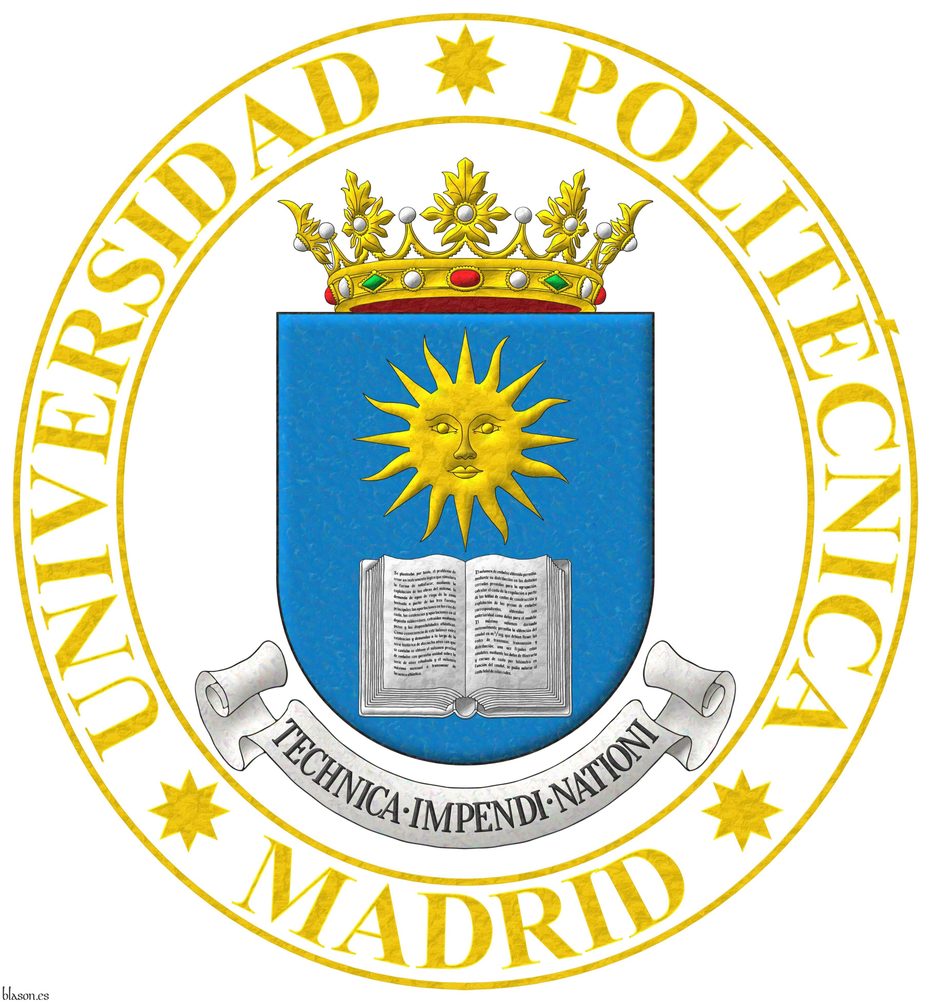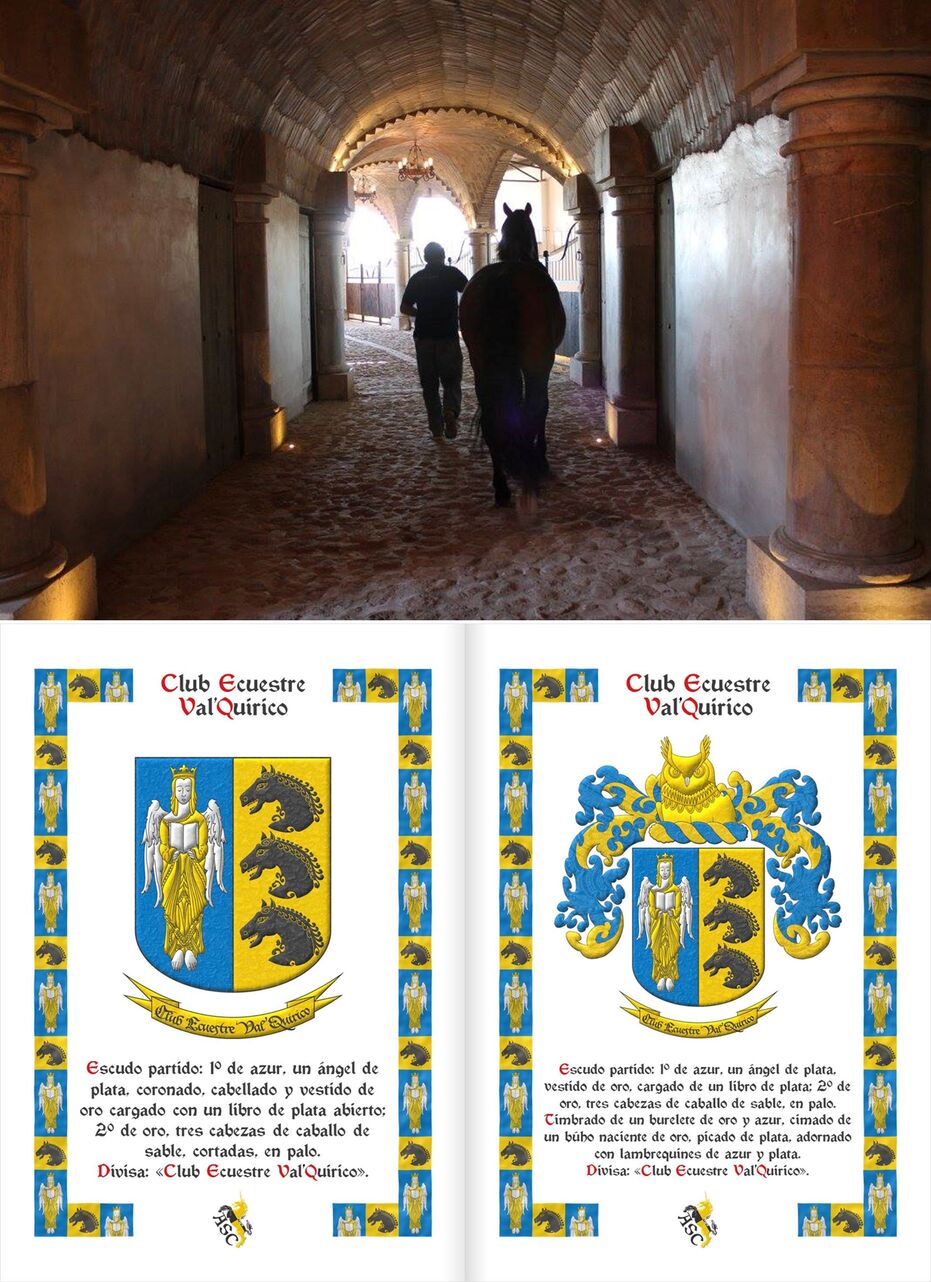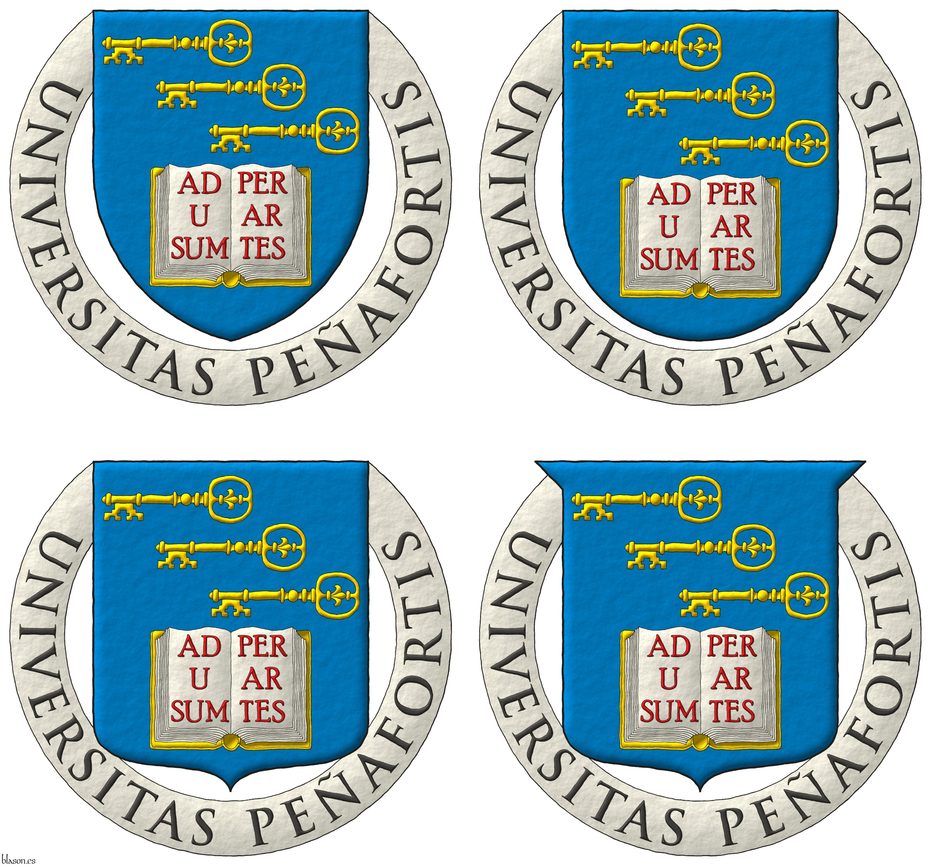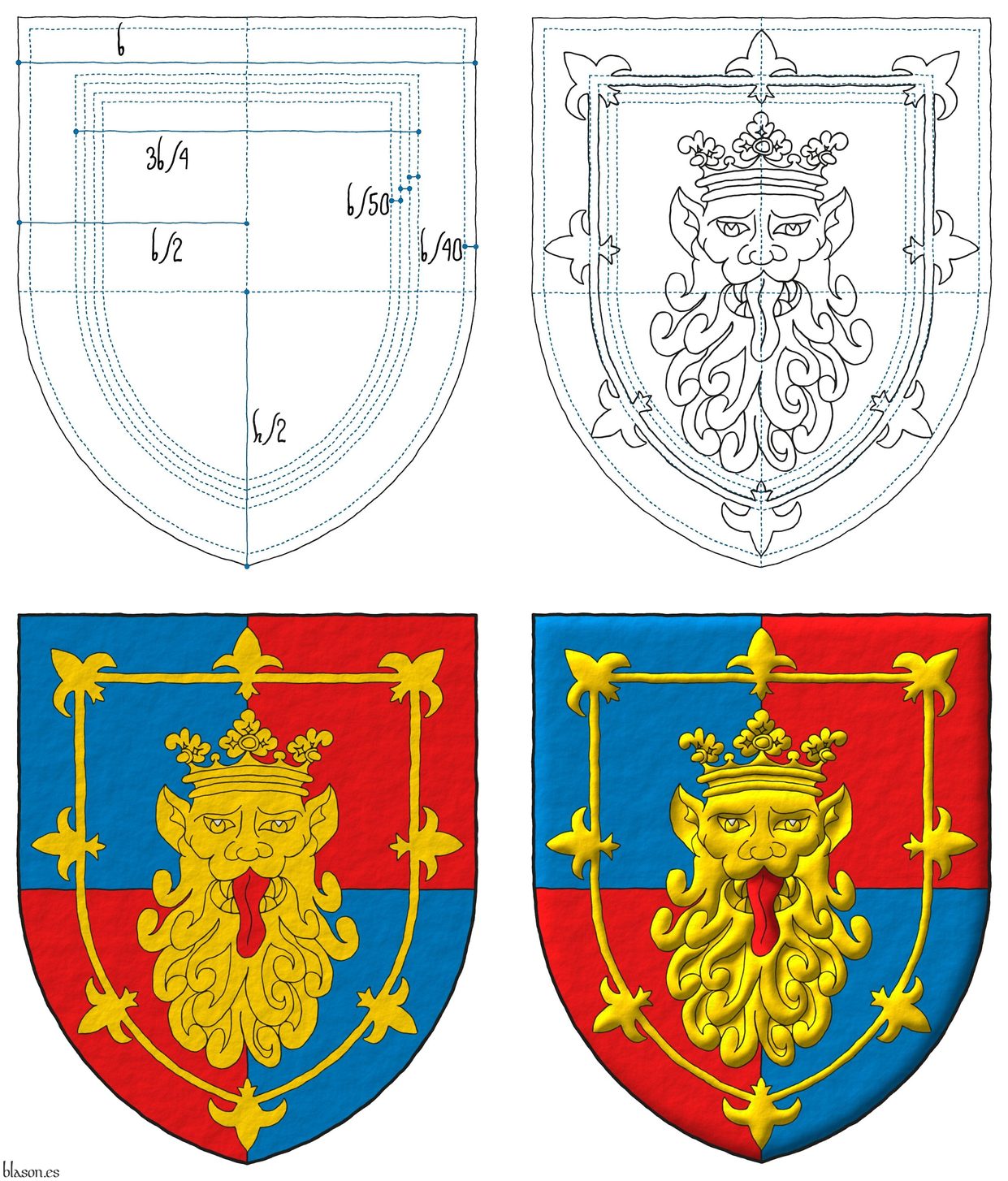Socioeconomic heraldry

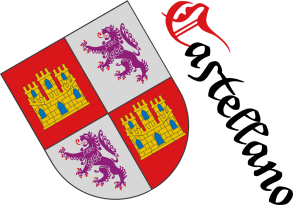
![Ver [Socioeconomic heraldry] en criterios utilizados. Unicornio saltante sobre la divisa, criterio.](../css/Unicornio.Criterio.png)
Within socioeconomic heraldry, I classify the arms of all collectives not included in the previous categories, such as, for example, commercial societies, which may represent companies, their brands, and products, sports clubs and federations, associations, professional colleges, educational institutions, arms granted or assumed collectively, etc.
For example, the coats of arms of universities, both private and public, belong to this category, the former naturally and the latter considering their appropriate autonomy from state powers. In this way, the coat of arms of the IESE, as a business school, is an example of socioeconomic heraldry.
Also included are the coats of arms of associations, like the Norsk Heraldisk Forening, and of companies, such as the arms of Alea Capital.
This category partially coincides with what [Cadenas y Vicent, V. de; 1975; page 119] refers to as «representative heraldry».
Categories: Criterion and Socioeconomic.


IESE
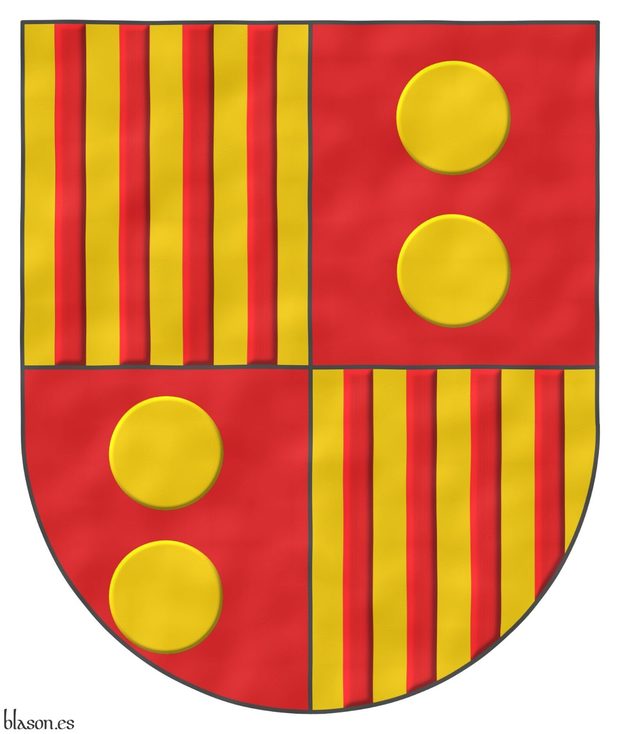
Quarterly: 1 and 4 Or, four pallets Gules; 2 and 3 Gules, two bezants in pale.
Escudo cuartelado: 1o y 4o de oro, cuatro palos de gules; 2o y 3o de gules, dos bezantes en palo de oro.
Coat of arms of the IESE Business School, which I have interpreted as follows: the shield has a semicircular (round) base; the field is illuminated in flat tinctures Or and Gules; the pales and the bezants are illuminated in Gules and Or; and the whole coat of arms has a watercolor finish.
I have the honour of holding a Master’s Degree in Business Administration from IESE of the University of Navarra. I always say that, as a whole, the IESE Executive MBA is the best education I have received throughout my life. I keep very good memories and friends from those two years of study.
Blazon keywords: Quarterly, Gules, Or, Pale, Bezant and plate and In pale.
Style keywords: Semi-circular, Illuminated and Watercolor.
Classification: Interpreted, Socioeconomic, Education and Coat of arms.
Bearer: IESE.


UNAV
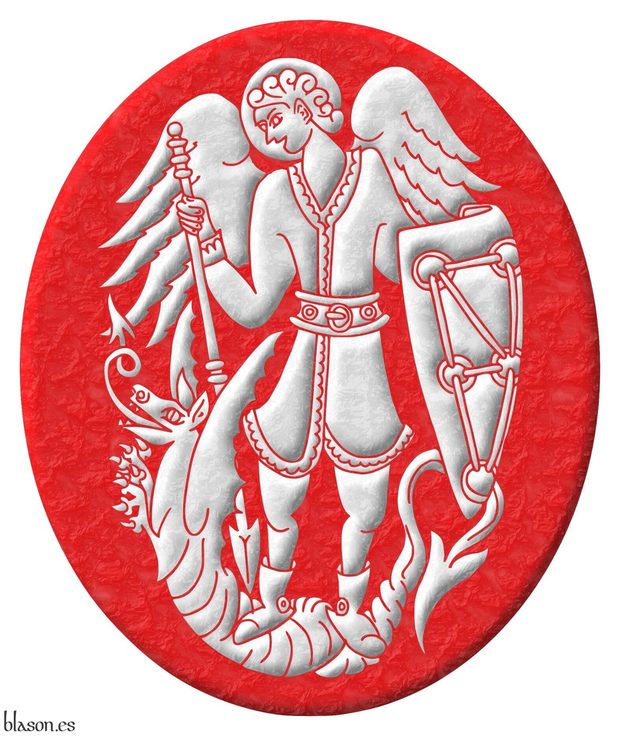
Emblem Azure, Saint Michael, grasping in his dexter hand a spear, point downward, and in his sinister hand bearing a coat of arms, upon a dragon Argent.
Emblema de azur, un Arcángel Miguel, teniendo en su diestra una lanza, con la punta hacia abajo y en su siniestra un escudo, sostenido por un dragón, todo de plata.
Two tinctures emblem interpreted as follows: an oval shape with a 5x6 proportion; the field illuminated in Gules, unlike its original colour; all its charges illuminated in Argent and outlined in the colour of the field; and the finish is marble-like.
The IESE Business School, where I studied, is the business school of the University of Navarre.
I also have the honour of having collaborated for years with the University of Navarre.
Blazon keywords: Without divisions, Gules, Male figure, Angel, Archangel, Argent, Grasping, Dexter, Spear, Point downwards, Sinister, Upon and Dragon.
Style keywords: Oval, Illuminated, Outlined in the field tincture and Marmoreal.
Classification: Interpreted, Socioeconomic, Education, Emblem and Kingdom of Navarre.
Bearer: University of Navarra.


UBU
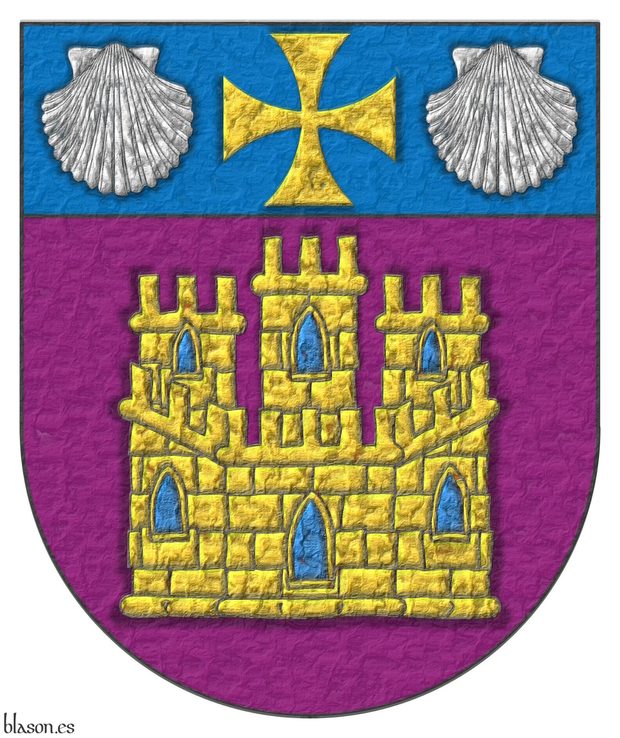
Purpure, a castle triple-towered Or, port and windows Azure, masoned Sable; on a chief Azure, a cross patty Or, between two escallops Argent.
Escudo de púrpura, un castillo de oro, aclarado de azur, mazonado de sable; un jefe de azur, cargado de una cruz patada de oro acompañada de dos veneras de plata.
Coat of arms interpreted as follows: with a semicircular (round) base; the field and the chief in the flat tinctures Purpure and Azure, with a lightly-hammered metal finish; and the four charges outlined in Sable, shaded, illuminated, and with a very hammered metal finish.
I hold the University Specialist degree in Real Estate Management and Administration, awarded by the Department of Private Law of the University of Burgos. These studies are structured over three academic years and are pursued online in combination with periods of traditional classes in the summers and on-site examinations during the winters. This was my first long-term online training experience.
Blazon keywords: Purpure, Or, Azure, Sable, Argent, Castle, Chief, Cross, Cross patty, Cross couped and Escallop.
Style keywords: Semi-circular, Illuminated, Shaded, Outlined in sable, Soft metal and Hard metal.
Classification: Interpreted, Socioeconomic and Education.
Bearer: Burgos, University of.


Technica impendi nationi
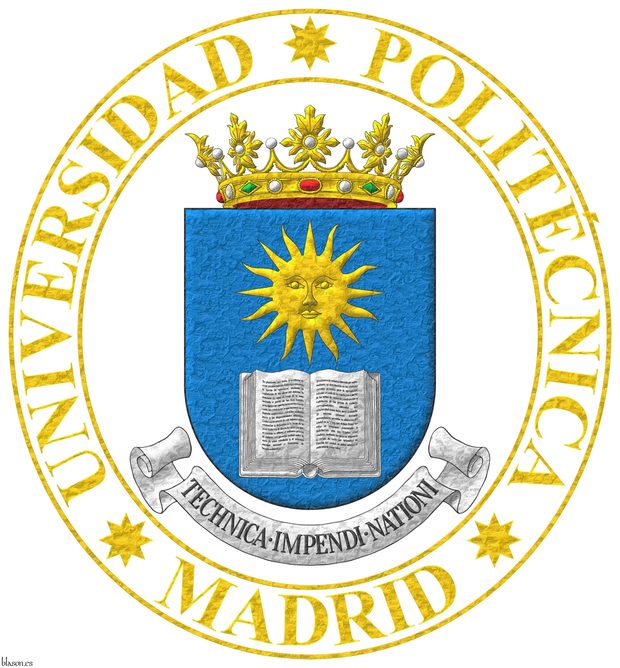
Azure, in base an open book Argent, in chief a sun in splendour Or. Crest: An open royal crown. Motto: «Technica impendi nationi». Motto around the shield: «Universidad de Politécnica de Madrid» fimbriated and depinted Or.
Escudo de azur, un libro abierto de plata surmontado de un sol de oro. Timbrado de una corona real abierta. Lema: «Technica impendi nationi». Divisa alrededor del escudo: «Universidad de Politécnica de Madrid» perfilada y en letras de oro.
Coat of arms interpreted as follows: a semicircular (round) base; the field in flat Azure; the field and charges are illuminated in the tinctures Azure and the metals Argent and Or, all outlined in Sable; my rendition of this coat of arms differs from others in that the sun’s rays, although outlined in Sable, are Or; in the legibility of the text written on the book; and in separating with a dot the words that form the motto; and the whole finished with a beaten-metal effect.
Metal batido y anacarado
Blazon keywords: Without divisions, Azure, Argent, Or, Book, Sun in splendour, Crest and mantling, Crown, Open royal crown, Motto and Motto (identification).
Style keywords: Semi-circular, Oval, Illuminated, Outlined in sable and Metal beaten.
Classification: Interpreted, Socioeconomic and Education.
Bearer: Technical University of Madrid.


Val'Quirico, the equestrian club's facilities, 3
Party per pale: 1 Azure, an angel Argent, crowned, crined and vested Or holding an open book Argent; 2 Or, three horses' heads couped, in pale Sable. Crest: Upon a wreath Or and Azur, an owl's head couped at the shoulders Or, beaked Argent. Mantling: Azur doubled Or.. Motto «Club Ecuestre Val’Quirico».
Blazon keywords: Party per pale, Azure, One, Angel, Argent, Crowned, Crown, Crined, Vested, Or, Charged, Book, Open, Three, Head, Horse, Sable, Couped, In pale, Crest and mantling, Wreath, Owl, Nascent, Beaked, Mantling and Motto (identification).
Style keywords: Crystalline, Illuminated, Rounded, Outlined in the field tincture, Outlined in sable and Diapered.
Classification: Photographic, Catalogue, Heraldic document, Created and Socioeconomic.
Bearer: Club Ecuestre Val'Quirico.


Del Fabbro Universidad
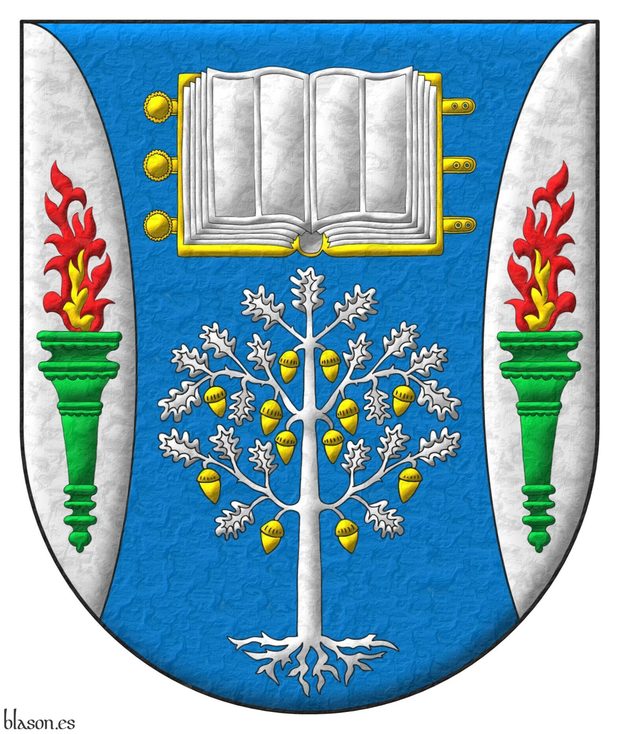
Azure, flanched Argent: in chief, an open book Argent, garnished Or; in base, an oak eradicated Argent, fructed Or; in each flank, a torch Vert, enflamed proper.
Escudo de azur, flanqueado curvo de plata: en jefe, un libro abierto de oro, hojado de plata; en punta, un roble arrancado de plata, frutado de oro; en cada flanco, una antorcha de sinople, encendida al natural.
Coat of arms devised by me, illuminated with lights and shadows, contoured in Sable, with a semi-circular outer contour and with a metal beaten finishing.
Blazon keywords: Azure, Argent, Or, Vert, One, Two, Flanched, In chief, Open book, Book, Garnished, In base, Oak, Tree, Eradicated, Fructed, In each flank, Torch, Enflamed and Proper.
Style keywords: Outlined in sable, Illuminated, Semi-circular and Metal beaten.
Classification: Socioeconomic, Created, Boa and Coat of arms.
Bearer: Del Fabbro Universidad.


Alea Capital
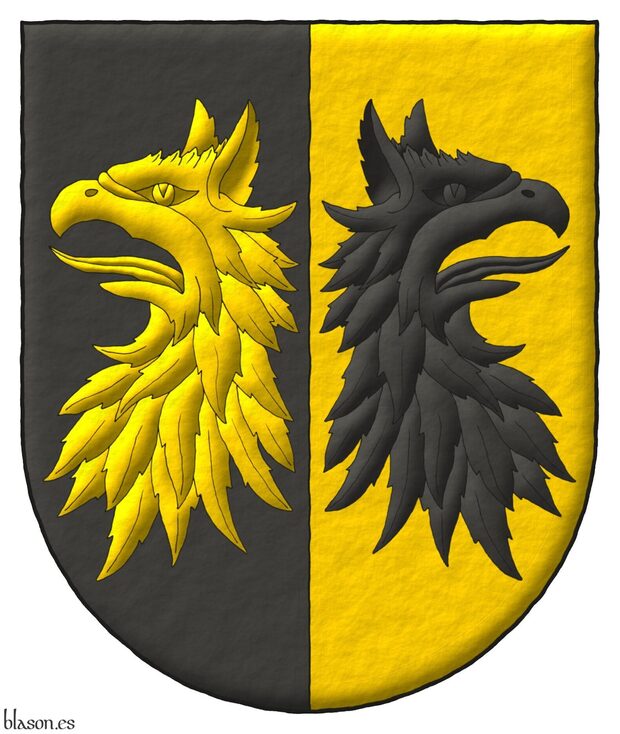
Party per pale Sable and Or, two griffins' heads eraticted, and addorsed counterchanged.
Escudo partido de sable y oro, dos cabezas de grifo arrancadas y adosadas del uno en el otro.
Coat of arms emblazoned by me with a semi-circular shape, illuminated, and with a freehand finishing.
Blazon keywords: Party per pale, Sable, Or, Two, Head, Griffin, Erased, Addorsed and Counterchanged (side-by-side).
Style keywords: Outlined in sable, Semi-circular, Illuminated and Freehand.
Classification: Socioeconomic, Created and Coat of arms.
Bearer: Alea Capital.


Lincoln's Inn, The Honourable Society of
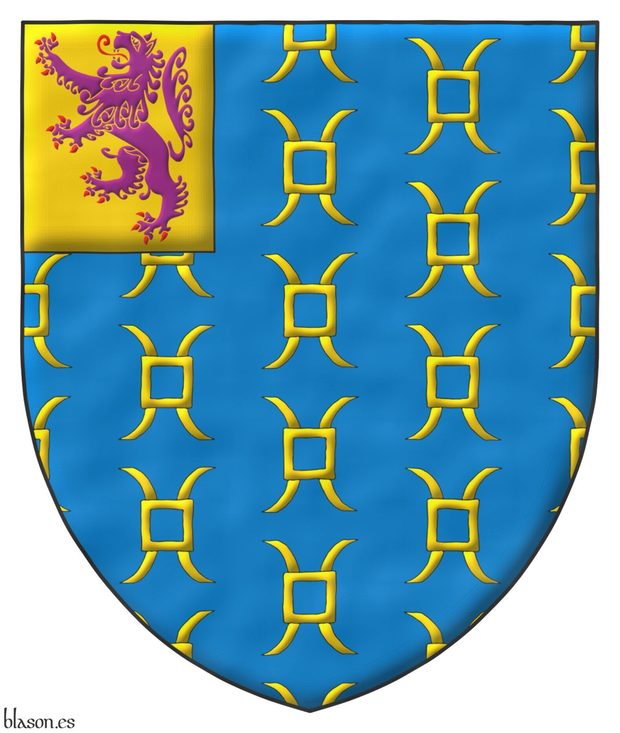
Azure semé of millrinds Or; on a dexter canton Or, a lion rampant Purpure, armed and langued Gules.
Escudo de azur sembrado de anillas de molino de oro; en un cantón diestro de oro, un león rampante de púrpura, armado y lampasado de gules.
Coat of arms emblazoned by me with a pointed shape, the lion is outlined with the color of the field, Purpure, the millrinds are outlined Sable, all the coat of ars is illuminated, and with a watercolor finishing.
Blazon keywords: Azure, Semé, Millrind, Or, One, Canton, Dexter, Lion, Rampant, Purpure, Armed, Langued and Gules.
Style keywords: Pointed, Outlined in sable, Outlined in the field tincture, Illuminated and Watercolor.
Classification: Socioeconomic, Interpreted and Coat of arms.
Bearer: Lincoln's Inn, The Honourable Society of.


Sovereign and Most Noble Order of the Pomegranate, page of armorial
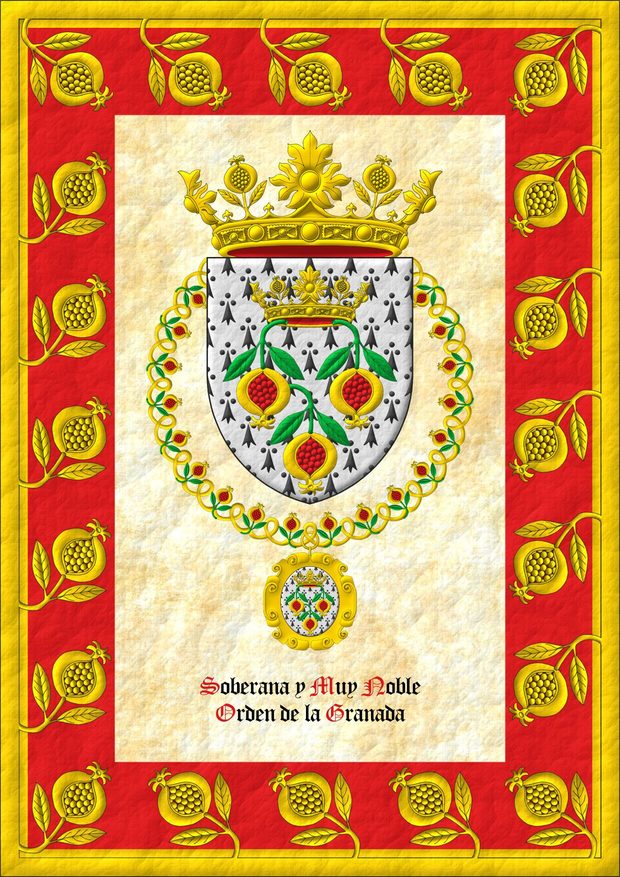
Ermine, three pomegranates inverted Or, seeded Gules, slipped and leaved Vert, ensigned with an open crown, alternating four rosettes of acanthus leaves, visible three, and four pomegranates Or, visible two, lined Gules. Crest: A crown of the Sovereign and Most Noble Order of the Pomegranate. The shield is surrounded by the Grand Collar of the Sovereign and Most Noble Order of the Pomegranate.
Blazon keywords: Without divisions, Ermine, Three, Pomegranate, Reversed, Or, Seeded (pomegranate), Gules, Slipped, Leaved, Vert, On, One, Crown, Alternately, Four, Rosette of acanthus leaves, Visible, Two, Lined, Crest and mantling, Surrounded and Grand collar.
Style keywords: Outlined in sable, Leather and Pointed.
Classification: Socioeconomic, Interpreted, Coat of arms, Armorial roll and Castilian language.
Bearer: Granada, Soberana y Muy Noble Orden de la.


Universidad Peñafort, 4 different shield shapes
Azure, in chief three keys in bend, fesswise, to dexter, facing downwards Or, in base an open book Argent, garnished Or, the pages inscribed «Ad usum per artes» Gules. Motto: «Universitas Peñafortis».
Illuminated and a freehand finishing.
Blazon keywords: Azure, Three, Key, Or, In chief, In bend, Fesswise, Book, Open, Motto and Motto (identification).
Style keywords: Freehand, Outlined in sable and Illuminated.
Classification: Socioeconomic, Created and Coat of arms.
Bearer: Peñafort, Universidad.


Trading Pro School
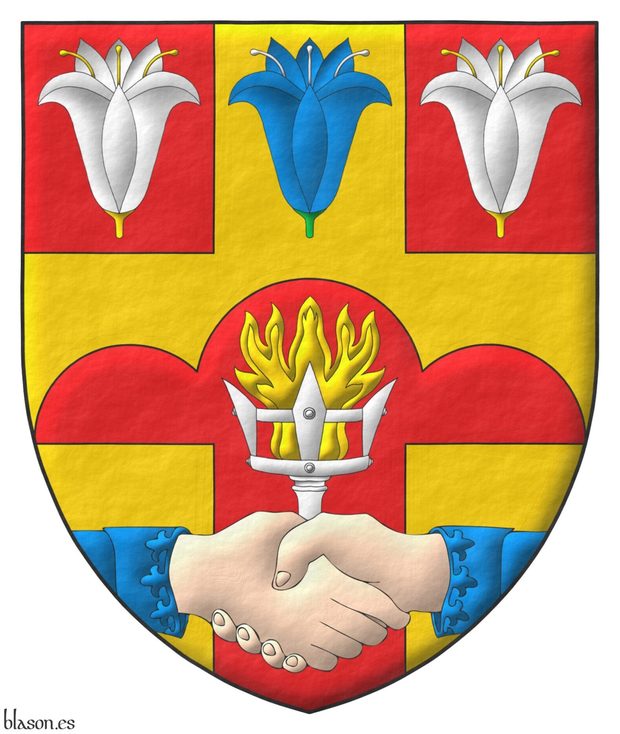
Illuminated and a rough finishing.
Blazon keywords: Gules, Cross, Or, Lily, Slipped, Seeded, Argent, Azure, Vert, In chief, Charged, Trimount, Counterchanged, Torch, In base and Two hands clasped.
Style keywords: Rough, Outlined in sable, Illuminated and Pointed.
Classification: Socioeconomic, Created and Coat of arms.
Bearer: Trading Pro School.


Triana, Hacienda de

Party per pale: 1 Argent, a tree issuant from base Murrey; 2 Murrey; two annulets interlaced, in pale Or; in a chief Sable, three arches Argent.
Escudo partido: 1o de plata, un árbol moviente de la punta de morado; 2o de morado, dos anilletes entrelazos, en palo de oro; en un jefe de sable, tres arcos de plata.
Coat of arms depicted by me, highlighted with lights and shadows, with a chasuble outer contour and with a watercolor finish.
The coat of arms of the Hacienda de Triana, Val’Quirico, Tlaxcala, Mexico, designed by Joaquin Haces Perdomo and me and emblazoned by me.
Blazon keywords: Sable, Argent, Murrey, Or, One, Two, Three, Party per pale, Tree, Issuant, Base, Annulet, Interlaced, In pale, Chief and Arch.
Style keywords: Illuminated, Chasuble and Watercolor.
Classification: Socioeconomic, Interpreted, Boa and Coat of arms.
Bearer: Triana, Hacienda de.


![Ver [Society of Heraldic Arts] en instituciones citadas. Fortaleza de oro y mazonada de sable.](../css/Fortaleza.Institucion.png)
Society of Heraldic Arts
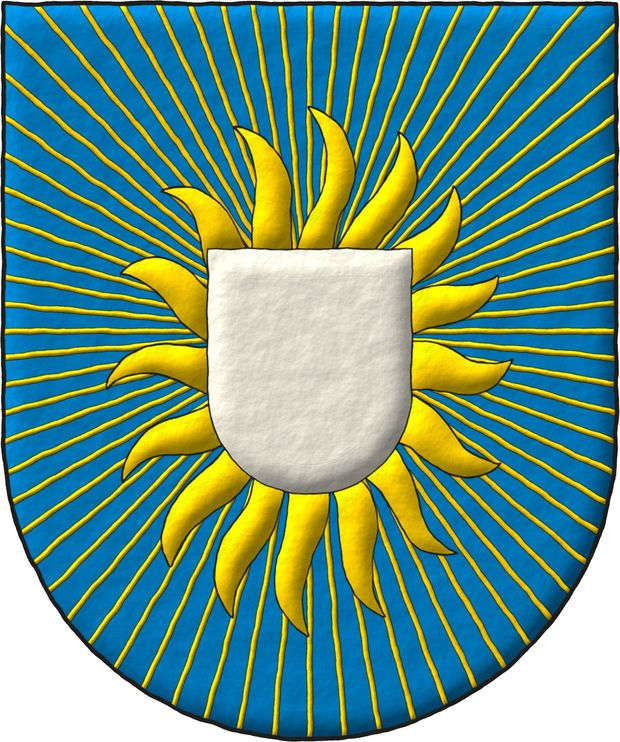
Founded in the year 1987, it is the first organisation of its kind in the world
Azure, an inescutcheon Argent, enflamed in orle of sixteen points and irradiated throughout of sixty-four lines Or.
Escudo de azur, un escusón de plata, llameante en orla de Dieciséis llamas y radiante de sesenta y cuatro líneas movientes todas de oro.
First versions
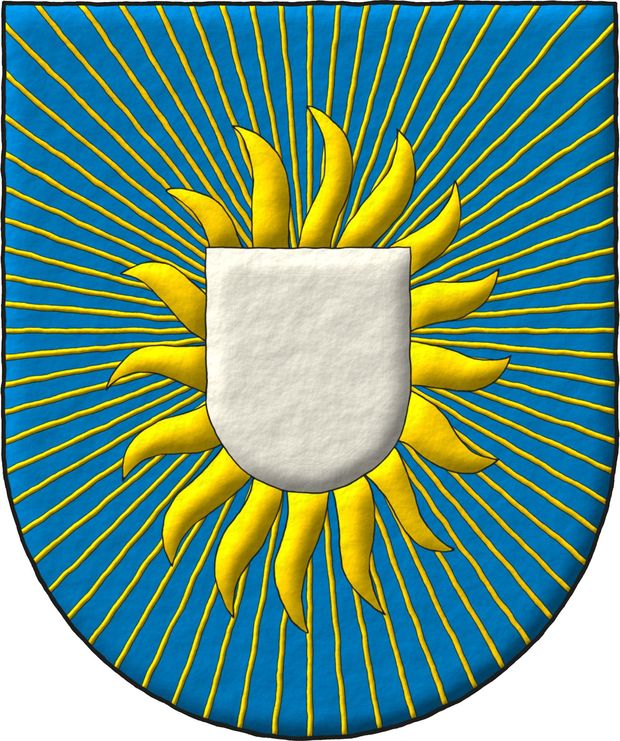
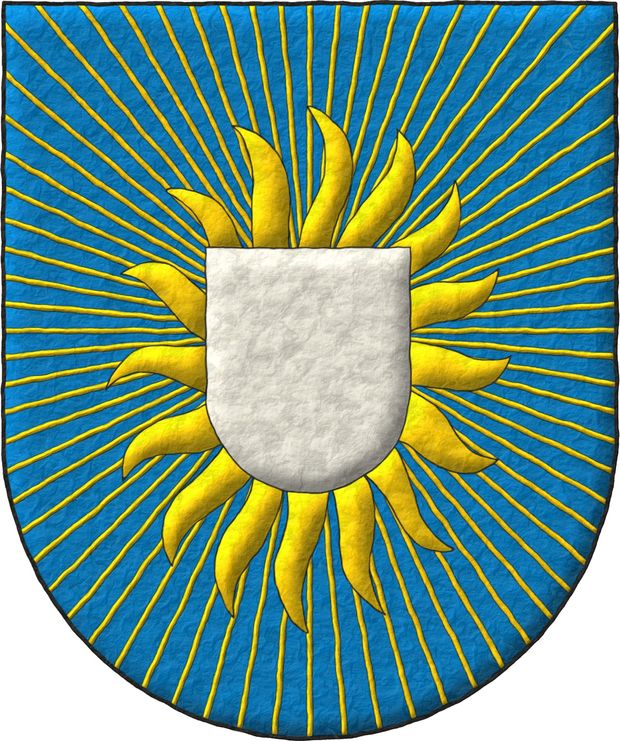
The Society of Heraldic Arts is an international organization founded in 1987, committed to the promotion and preservation of heraldic art. The society brings together artists, craftsmen, and enthusiasts who work in various forms of heraldic expression, from painting and sculpture to calligraphy and jewelry. With members worldwide, the SHA encourages the exchange of knowledge and skill development through exhibitions, publications, and events.
Categories: Institution, Interpreted, Socioeconomic, Illuminated, Semi-circular, Coat of arms, Azure, Inescutcheon, Argent, Enflamed, In orle, Sixteen, Flame, Irradiated, Sixty-four, Line, Throughout (all sides) and Or.


![Ver [Norsk Heraldisk Forening] en instituciones citadas. Fortaleza de oro y mazonada de sable.](../css/Fortaleza.Institucion.png)
Norsk Heraldisk Forening
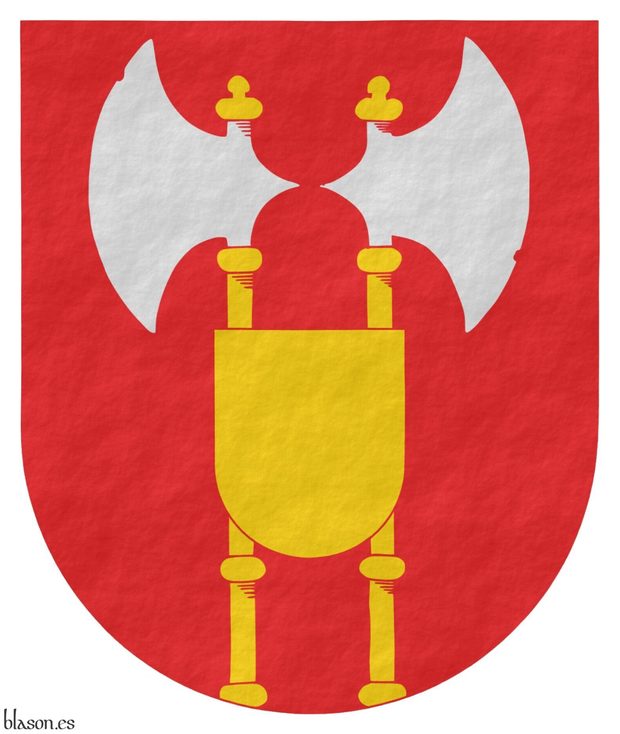
Norsk Heraldisk Forening, in English, Nordic Heraldry Society, was founded on February 27, 1969, at the National Archives in Oslo, with the aim of promoting the study and knowledge of heraldry through meetings, lectures, excursions, and other dissemination methods, and additionally, to become an advisory body to resolve issues in matters of heraldry, flags, personal coats of arms, etc. Its first president was Dr. Philos Herman L. Løvenskiold.
Since then, these have remained the objectives of the Norsk Heraldisk Forening, and its membership count has remained between 150 and 200 members, and it cooperates with the Nordic Heraldry Society, «Societas Heraldica Scandinavica».
The website's address is Heraldikk.no, its content is available in both Norwegian and English, and they work systematically to expand it and provide greater and better information to both its members and those interested in heraldry.
Blazon
Alex Maxwell Findlater described it in English, including its crest, in an article that was on their previous website under the title «About the society», as follows: «Gules issuant from base two battle-axes addorsed Argent shafted Or overall at the nombril point an escutcheon Or; for Crest between two axes of the arms a panache of three peacock feathers proper; Mantling Gules doubled Or». But given that «shafted» applies to weapons with a shaft and «hafted» to weapons with a handle, in the case of axes, I use «hafted» although both terms correspond to the Spanish «fustado».
Note how the axes are described as battle-axes, just as in the blazon of the Norwegian coat of arms, where its lion holds a battle-axe.
Coat of arms I attempted to interpret in the Norwegian style, all in flat tinctures, without Sable outlines, lighting or shading, and only with a simple rough finish.
Categories: Institution, Interpreted, Socioeconomic, Semi-circular, Plain tincture, Outlined in the field tincture, Rough, Coat of arms, Without divisions, Gules, Axe, Argent, Hafted, Or, Addorsed, Issuant from base, Overall, At the nombril and Escutcheon.


![Ver [Registro Internacional de Armas Gentilicias] en instituciones citadas. Fortaleza de oro y mazonada de sable.](../css/Fortaleza.Institucion.png)
Registro Internacional de Armas Gentilicias
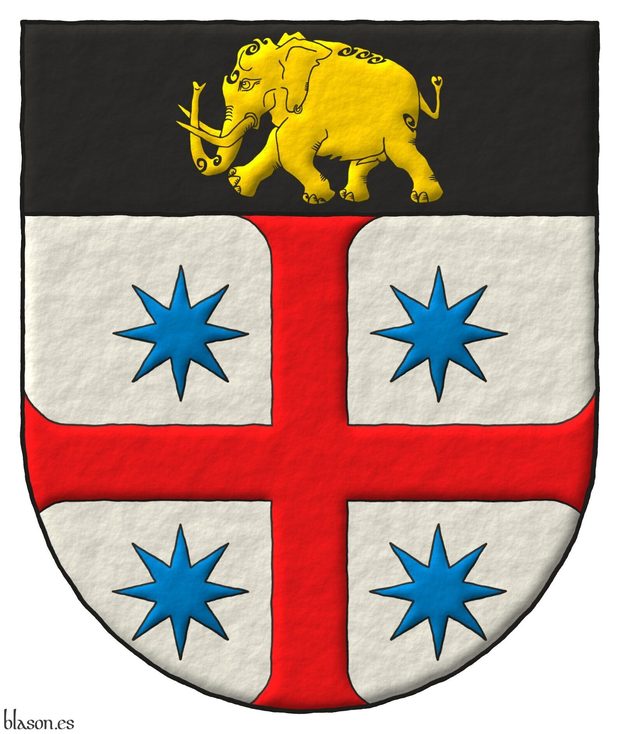
RIAG
Argent, a cross patty Gules, cantoned of four mullets of eight points Azure; on a chief Sable, an elephant passant Or.
The Registro Internacional de Armas Gentilicias, is also known as RIAG, and riag.com.es is it domain.
It is a private register of coat of arms founded in 2006 in Seville, Spain by the herald Ignacio Koblischek Zaragoza.
Categories: Institution, Socioeconomic, Semi-circular, Illuminated, Outlined in sable, Outlined in the field tincture, Freehand, Argent, Diminished cross, Patty, Gules, Cantoned, Mullet, Eight, Azure, Chief, Sable, Elephant, Passant and Or.


![Ver [Royal Council of the Orders of Chivalry] en instituciones citadas. Fortaleza de oro y mazonada de sable.](../css/Fortaleza.Institucion.png)
Royal Council of the Orders of Chivalry

In 1523, the Order of Santiago, the Order of Calatrava, and the Order of Alcantara were definitively incorporated into the Crown of Castile, which marked the consolidation of the Royal Council of the Orders of Chivalry of Santiago, Calatrava, Alcantara, and Montesa. However, it is known that this Royal Council already existed at the beginning of the same 16th century, or even earlier, although there are no foundational documents available to date its inception.
The internet address of its website is ordenesmilitares.es where it also hosts the pages dedicated to each of its four orders:
- Order of Chivalry of Santiago: ordenesmilitares.es/orden-de-santiago.
- Order of Chivalry of Calatrava: ordenesmilitares.es/orden-de-calatrava.
- Order of Chivalry of Alcantara: ordenesmilitares.es/orden-de-alcantara.
- Order of Saint Mary of Montesa and Saint George of Alfama: ordenesmilitares.es/orden-de-montesa.
After the Crusades ended and following the model of the military orders created in the Holy Land, European kings established Orders of Chivalry, many of which were military and religious institutions, like the four grouped under this Royal Council.
Categories: Institution, Interpreted, Socioeconomic, Illuminated, Outlined in sable, Freehand, Emblem, Cross, Quarterly per saltire, Cross of Saint James, Cross couped, Cross of Calatrava, Cross of Alcantara and Cross of Montesa.


The Heraldry Society, schema
The coat of arms of The Heraldry Society emblazoned by me in 4 steps: 1) ratios, 2) delineation, 3) plain tincture, and 4) lights and shadows. Blazon: Quarterly Azure and Gules; overall a leopard face, crowned Or, langued Gules, within a tressure flory Or.
Blazon keywords: Quarterly, Azure, Gules, Overall, Head, Leopard, Crowned, Or, Langued, Within, Tressure and Flory.
Style keywords: Pointed, Illuminated, Outlined in sable, Shaded and Freehand.
Classification: Interpreted, Socioeconomic, Coat of arms and Schema.
Bearer: The Heraldry Society.
-
Language
-
Categories of heraldry
-
Divisions of the field
- Without divisions
- Party per pale
- Party per fess
- Party per bend
- Party per bend sinister
- Tierce
- Tierce sinister
- Tierced per fess
- Tierced per bend
- Tierced pallwise inverted
- Quarterly
- Quarterly per saltire
- Gyronny
- Party per fess, the chief per pale
- Party per pale, the sinister per fess
- Party per fess, the base per pale
- Party per pale, the dexter per fess
- Chapé
- Chaussé
- Party per chevron
- Enté en point
- Flanched
-
Metals
-
Colours
-
Furs
-
Other tinctures
-
Ordinaries and sub-ordinaries
-
Diminutives of the ordinaries
-
Other charges
-
Charges from Nature
Water, Eagle, Bald eagle, Eagle claw, Dorsal fin, Tail fin, Two hands clasped, Lark, Tree, Trunk, Rainbow, Atom, Barbel, Acorn, Bighorn sheep, Arm, Owl, Vulture, Horse, Head, Goat, Camellia, Thistle, Merino ram, Kapok tree, Stag, Doe, Crescent, Increscent, Chrysanthemum, Tail, Tail addorsed, Ermine spot, Hummingbird, Snowflake, Heart, Roe deer, Neck, Roe deers' attires, Raven, Dolphin, Diamond, Tooth, Elephant, Emerald, Starling, Mullet, Mullet of four points, Star of David, Estoile, Male figure, Fleur de lis, Flower, Cornflower, Dogwood flower, Lotus flower, Hop cone, Bluebonnet, Puffin, Ash, Rooster, Claw, Talon, Goose, Heron, Seagull, Pomegranate, Sunflower, Swallow-tail, Falcon, Leaf, Boar, Goldfinch, Laurel, Barn owl, Lion, Lioness, Lion passant, Leopard, Lion rampant guardant, Lynx, Lily, Madonna lily, Flame, Wolf, She-wolf, Parrot, Moon, Hand, Apple, Apple tree, Martlet, Wing, Two wings in vol, Covert, Blackbird, Mount, Trimount, Fly, Wrist, Elm, Olive tree, Orbital, Bear, Palm frond, Palm tree, Dove, Poplar leaf, Panther, Jaguar, Vine, Paw, Forepaw, Foot (palmiped), Foreleg, Peacock, Chest, Pelican, Pelican in her piety, Dog, Brach hound, Fish, Hoof, Beak, Quill, Cinquefoil, Quetzal, Branch, Sprig, Frog, Shamrock, Caboshed, Oak, Holm oak, Rose, Double rose, Savage, Serpent, Plough of Ursa Major, Sun, Sun in splendour, Ray of the sun, Lightning flash, Stem, Badger, Tyger, Linden, Wheat, Wheat spike, Bull, Tulip, Udder, Escallop and Fox.
-
Artificial charges
Halberd, Plough share, Ace of spades, Anchor, Cyclamor, Torch, Bow, Arch, Harp, Non-classic artifact, Winnowing fan, Crozier, Conductor's baton, Pair of scales, Ship, Norman ship, Beret, Grenade, Ecclesiastical cap, Arm vambraced, Knight, Chain, Covered cup, Monstrance, Bell, Bell tower, Cannon dismounted, Carbuncle, Castle, Ribbon, Clarion, Nail, Cord, Dagger, Key ward, Turret, With a turret, Armillary sphere, Sword, Federschwert, Sabre, Parchment, Scroll, Arrow, Club, Garb, Sheaf of tobacco, Scythe, Gauntlet, Axe, Buckle, Galician granary, Polish winged hussar, Church, Oil lamp, Spear, Spear's head, Fleam, Letter, Book, Open book, Closed book, Bookmark, Page, Line, Lantern, Key, Four crescents joined millsailwise, Hammer, Menorah, Mortar, Pestle, Number, Knot, Celtic Trinity knot, Water-bouget, Comb, Piano, Millstone, Millrind, Millwheel, Clay pot, Bridge, Cuffed, Hourglass, Chess rooks, Compass rose, Rosette of acanthus leaves, Mullet of six points pierced, Broken, Portcullis, Wheel, Wagon-wheel, Symbol, Sackbut, Drum, Geometric solid, Tetrahedron, Tower, Trident, Trumpet, Double vajra and Anvil.
-
Immaterial charges
Angel, Archangel, Heart enflamed, Sacred Heart of Jesus, Paschal lamb, Dragon, Wyvern, Phoenix, Garuda, Griffin, Sea-griffin, Winged hand, Our Lady of Mercy, Pegasus, Saint George, Mermaid, Trinity, Triton, Golden fleece, Unicorn and Ouroboros.
-
External elements
-
Heraldic creations
-
References
-
Formats
-
Keywords on this page
Open, Watercolor, Addorsed, Torch, Pointed, Azure, Boa, Overall, Head, Charged, Crown, Crowned, Created, Cross, Cross couped, Quarterly, Outlined in sable, Outlined in the field tincture, Dexter, Motto (identification), Two, Education, Emblem, In chief, In pale, In base, Coat of arms, Gules, Illuminated, Institution, Interpreted, Chief, Langued, Motto, Book, Enflamed, Semi-circular, Metal beaten, Or, Party per pale, Argent, Without divisions, Sable, Vert, Socioeconomic, Crest and mantling, Freehand, Three and One.
